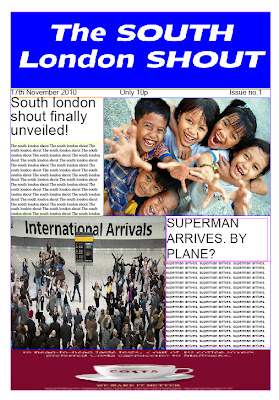3. What have you learned from your audience feedback?
Throughout the production of my product audience feedback has been vital, it allows me to see any mistakes I may not have noticed myself, I was able to see whether or not my work is actually appealing to my demographic.
Newspaper:
At first I wanted to use a name plate that looked like this:
But after receiving some feedback I found that no one really liked this and they would be unlikely to buy the newspaper with a nameplate as plain as this.
I also learned that the layouts I had created did not allow my reader to have enough option in what they read, which is ideal for a local newspaper that is just launching, but I was unable to do this because of a lack of space on the A3 paper I was using. Below is the first mockup of the front cover.
This layout allows room for two articles but it is not obvious which article is the main article. This was something that, according to me feedback, that could deter a possibly reader.
When this didn’t work I tried this cover:
This is the layout I ended up using. This layout received a very positive response from my classmates and tutors. They also suggested that on my nameplate, I should put “Battersea” or “Battersea Edition” so that it is more obvious who the newspaper is meant for.
On the inside page of my newspaper the layout of my newspaper was dictated by the typical conventions of a local newspaper.
From feedback I learned that there needs to be more colour but that I should also keep the “neat” appearance that I have already created.
Ancillary 1 – Poster:
From feedback on my poster I learned that the colours and fonts I have used are the same as the font used on the newspaper, this helps the newspaper be identified through the poster.
I also learned that the clarity of the text on the poster was not clear, and people had difficulty reading the price, and all of the text.
Ancillary 2 – Radio Advert
In order to get feedback on my second ancillary task, I asked a group of people that fit my demographic; males and females of mixed ethnic backgrounds that live in Battersea and are between the ages 20 and 50.
They listened to the advert and told me it was really good, but when I told them the demographic they were surprised and told me that they did not think it was meant for them. They told me that the reason they didn’t think it was for them is because the woman doing the voice over sounds too young, and her voice was monotonous, and they said that it would be better if the voice over was done by a person within the demographic, that would be the best way to make them able to relate to it. They also told me that the music is too loud, especially toward the end.
I also asked a media studies graduate to listen to my radio advert critically, she told me that:
1) I need to repeat the name of the newspaper at the end of the advert because people tend to focus more towards the end.
2) The volume of music should be lower.
3) I should have a 3 second opening with just music.
4) It’s important to use a voice that reflect the target audience, so that the audience can relate, especially as they cannot see the person, the voice is very important
5) There needs to be more of a gap between the gibberish and the speech, you can barely tell that she has asked a question and offered a solution.
4. How effective is the combination of your main product and ancillary texts?
I have linked all my print based products through the use of colours, fonts and content. In my main task – newspaper cover and inside page – I used the same font for the articles and headlines, the font used for the nameplate dictated the font for all headings (e.g. “out and about”, and “in todays shout”). My cover page and inside page are linked by the “days out in London” article; I did this in the hope that people that read the cover, and are interested in the article, will follow it from the cover to the second page. This is something that is done often in newspapers, this shows that this method is effective for attracting the attention of readers, because when they see the article they like, they will be more likely to follow it from the cover to the inside. I think that I should have added a few more of these short stories, but due to a lack of space on the cover I decided not to.
In my ancillary products I used words to link the products. On my poster I used words like ‘community’, ‘news’, and the price ‘10p’. The use of the word community is used as a way to tell the reader what the newspaper is about and what it focuses on. As my ancillary products are meant to be ways of promoting my main product, I thought that it would best to make sure that the poster contained only information that will promote the content of the newspaper and its price, which is why I felt strongly about putting text behind the image. Another way I could have done this is to take different pictures and put small captions of what it is about, but if I did it like this it would have been difficult to link it to my radio advert. My radio advert focuses on the fact that this is a community newspaper that is new, interesting and affordable.























